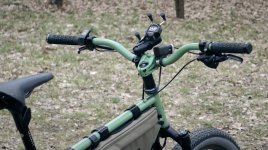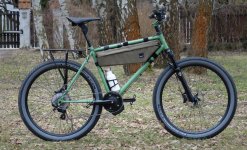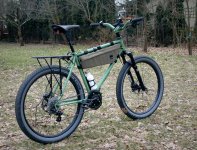martin.shane said:
Thank U Casainho
Wireless with Garmin edge would be perfect. Im frame bulider and i have strong mechanical skills however my electronic skills are limited. I mean electricity YES but electronics not so much. So I must way for some ready to go wireless module . May be Eco Cycle will do it in a near future.
For sure for me going wireless i a best option.
Im building 29r now on own frame and solving some chainline issues . It will be a bikepacking bike. The idea is to make it look analog as much as I can do , including internal routing for cables and so on.
For me in OSF most important is that I can see power consumption and how hard I need to pedal to make a long distance ( human power indicator). I will try to find the way to optimize it for a distance and as much support I can get.
I have another bike , full MTB and this one will be optimized for Torque. I think it would be grat option if we could use profiles .
It would be helpful also when somebody like me using 2 different battery packs ( one is 14 Ah , 2nd 17,5 Ah - 2 different cells are use)
Again , thank u for U hard work.
Oh, frame builder... I am in contact with one that will build a micro cargo bike for me and where I will install a TSDZ2

I already did some long travels but never really bikepacking, but I wish to do it some day, I really like the adventure side

So, for optimizing to low power for bikepacking travels, our firmware is the best you can get and I would:
- reduce current ramp
- disable field weakening
- config motor max power like if my battery have 300Wh, I would configure motor max power to 75W, so 300 / 75 = 4 hours continuous riding. Assuming I have the same amount of ascendings as descendings, etc, I assume I will use the motor only 60% of the time, then I hope to have battery for 6.5 hours of riding
- reduce battery low voltage value to be the minimum as possible, to fully discharge them and so get the max energy possible
- configure the battery resistance to have the best accuracy on the battery SOC
And yes, our fully wireless remote controller, other than controlling TSDZ2 with the 3 buttons, the 4th button is used to change the page of Garmin Edge!! The remote connects simultaneously to the TSDZ2 Ebike wireless controller and to the Garmin Edge!!
Profiles? could be implemented on the mobile app. Mobile app reads and sends the configurations to the TSDZ2 EBike wireless controller, so various profiles would be on the mobile app and each one would send each configuration to the controller.
If you have strong mechanical skills, did you thought already if there is a way to reduce the noise of TSDZ2 on the mechanical gears?








